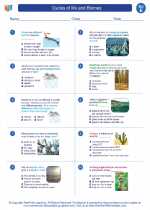Streams
A stream is a body of water that flows in a channel. Streams can be found in various environments, including mountains, forests, and plains. They play a crucial role in the water cycle and the overall health of ecosystems.
Formation of Streams
Streams are formed by the flow of water from higher to lower elevations. The primary sources of water for streams are precipitation (rain and snowmelt) and groundwater. As the water flows over the land, it collects in low-lying areas, gradually forming channels that define the stream's path.
Characteristics of Streams
Streams can vary in size, speed, and flow. The characteristics of a stream are influenced by factors such as the volume of water, the slope of the land, and the type of rock and soil in the area. Some key characteristics of streams include:
- Channel: The pathway through which the water flows, often defined by the surrounding banks or bed.
- Velocity: The speed at which the water moves through the stream, influenced by the slope and volume of water.
- Gradient: The steepness of the stream's slope, which affects the speed and erosive power of the water.
- Discharge: The volume of water flowing through the stream at a given point, typically measured in cubic feet per second.
Importance of Streams
Streams play a vital role in the environment and support diverse ecosystems. They provide water for plants, animals, and human communities. Additionally, streams transport sediment and nutrients, contribute to the replenishment of groundwater, and serve as habitats for various aquatic organisms.
Study Guide
To deepen your understanding of streams, consider the following study guide questions:
- What are the primary sources of water for streams?
- How do the characteristics of a stream, such as velocity and gradient, influence its behavior?
- What role do streams play in the water cycle?
- Discuss the importance of streams in supporting ecosystems and biodiversity.
- How do human activities impact streams and their associated habitats?
Exploring these questions will help you gain a comprehensive understanding of the role of streams in the natural world and the interconnectedness of water systems.
.◂Science Worksheets and Study Guides Fifth Grade. Cycles of life and Biomes

 Worksheet/Answer key
Worksheet/Answer key
 Worksheet/Answer key
Worksheet/Answer key
 Worksheet/Answer key
Worksheet/Answer key
 Worksheet/Answer key
Worksheet/Answer key
 Vocabulary/Answer key
Vocabulary/Answer key
 Vocabulary/Answer key
Vocabulary/Answer key
